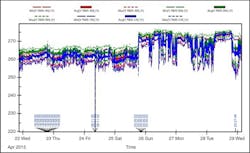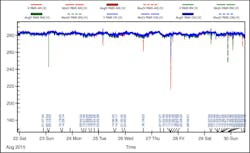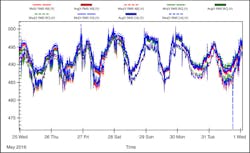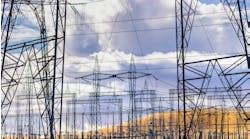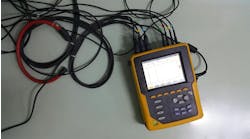The deployment of electronic LED lighting has grown dramatically over the past five years. Most luminaire manufacturers now offer a family of high-bay industrial LED products operating at AC line voltages (347V to 480V). Many industrial plants installed anywhere from a few hundred to a few thousand high-bay LED luminaires in their facilities. However, electronic LED drivers and fixtures were designed without truly understanding the electrical environments of industrial plants once using magnetic high-intensity discharge (HID) lighting operating at 480V.
As with other new electrotechnologies, manufacturers rushed to market with high-bay LED products to replace the inefficient magnetic HID technologies’ poor light quality. No efforts were made to understand the power quality performance of 480V lighting branch circuits. Stemming from the philosophy to protect outdoor LED street lighting, manufacturers assumed the only power quality threat to their drivers was voltage surges — ring wave and combination wave. Thus, large surge protective devices (SPDs) rated for 10kV at 10/20kA were included in LED luminaires as “add-on” SPDs to protect the driver(s).
Unfortunately for many end-users, high-bay LED luminaires installed in industrial plants failed at unacceptable rates from about 1% to as much as 50% two months to two years after installation. In some cases, failure rates would escalate within one year of the end of a five-year warranty. Reacting to failing LED lighting investment, users were forced to exercise their warranties.
Reacting to their customer demands, most manufacturers delivered replacement drivers. The cost of replacement drivers, however, was the smallest cost element required to get the lights back on in industrial plants where lighting is critical to maintaining safe work environments. With fixture counts ranging from a few hundred to a few thousand, many users were forced to absorb high electrical labor costs to remove failed luminaires, replace drivers, and re-hang fixtures. Re-hanging their old HID lighting fixtures was not an option, especially since installing industrial LED lighting was a much larger investment than repairing or replacing their HID technologies. The cost of interruption to plant operations was also difficult to absorb. This cost can range from tens of thousands to millions of dollars. After enduring the high total costs of repairing and replacing their industrial LED lighting — a cost that can be as high as $1 million — end-users quickly realized that the cost of power quality preparedness before engaging in an LED lighting retrofit project or new installation was many times less than the cost of recovering from failing LED lighting. The number of reactive power quality projects Electrotek has conducted for end-users and manufacturers is the stimulus for this article.
Power quality voltage trends on branch circuits at four different facilities
Figure 1(a) illustrates a voltage trend in a heavy industrial plant where LED driver failures occurred. You can see there is noticeable separation between the average RMS voltage from phase to phase. There are also noticeable steps in the phase-to-neutral voltages with one major step occurring on Saturday, April 25. Prior to this date, the voltages were running a little low, but still within industry limits. You can also see that after the major step, there were significant excursions in the phase-to-neutral voltage over the next several days. There was also a voltage sag on April 24. The other interest point here is that after reviewing recorded disturbances, many of these characteristics actually represent voltage transient events with high dV/dt. (High dV/dt values indicate the line voltage changed quickly with respect to time. The change in volts can only be 50 to a few hundred volts, but the change in time can be in the one microsecond (1 × 10-6 second, or 1 µsec) range. Values of dV/dt may be high enough to damage driver electronics but not have a high enough voltage to cause a metal-oxide varistor (MOV), external or internal to a driver, to clamp. Take a look at the date/time event markers. There are four groups of power quality disturbance sets. The first set (occurring on April 22 at 18:58:32) involves mutliple events as well as the second and third sets. The fourth disturbance seems to be a single event.
Figure 1(b) illustrates a voltage trend in a commercial facility where LED driver failures also occurred. Here, there seems to be about a 24-hour cyclic pattern to the phase-to-neutral voltage. The average voltage appears to be around 283V and is still within industry limits. However, there were four voltage sags that occurred at different times. The first one seems to be dominant on Phase B while the others seem to be dominant on Phase A. All of the sags occur at a different time each day. You can also see that there were multiple sets of power quality disturbance events here. Many who set a power quality monitor do not activate the right recording functions and fail to record critical disturbance data that helps to explain why LED drivers fail. Many simply look at a voltage trend like the ones presented in this article and determine that there are no power quality problems at a lighting panel or on a lighting branch circuit. However, many of these disturbances, in fact, were also recorded as voltage transients with high dV/dt values.
Figure 1(c) illustrates a voltage trend for a commercial outdoor LED street lighting application where LED driver failures occurred. At this location, the voltage has lots of transient activity characteristics. Transient activity always seems to occur in the morning hour when the lights turn off and in the evening hour when the lights turn on. The other times where disturbances were indicated by a time stamp in between “turn off” and “turn on” are when voltage transients occur upstream of the 120V circuit derived from utility distribution power also serving residences in the area. Reviewing properly recorded disturbances along with voltage trends helps explain why the LED failures occurred.
Figure 1(d) illustrates a voltage trend in a commercial facility where LED drivers also failed. At this location, there is no distinct pattern to the dates/times in between the 24-hour cycles when the line voltage produced a maxima and minima. However, there seems to be more transients at the voltage maxima and minima, especially for the four maxima in the center of the trend. This indicates the turning on and turning off of a heavy load, which produced voltage transients with high dV/dt values.
Notice that in the above four figures of a one-week voltage trend, the power quality at each monitoring point at these four voltage levels was significantly
different. However, it is difficult to identify enough information about the quality of the line voltages and currents by only conducting a one-week monitoring period. Monitoring periods here were at least one month.
Power quality disturbances and plant electrical systems
Power quality disturbances may originate from the incoming electric utility power feeder to a plant, but most are generated inside the plant’s electrical system, following the well-known ‘rule of thumb’ that most disturbances that cause malfunction and damage to electronic equipment originate inside customer facilities. Many industrial plants are fed at 4,160V to the switchgear. The voltage is then dropped down to 480V at the first transformer location. However, some plants are fed directly at 480V from the electric utility.
Non-linear loads, such as variable-frequency drives (VFDs) and other high-power equipment like induction motors, are powered at the 4,160V and 480V levels. These loads are powered at these higher voltage levels due to the amount of current they require to start up and operate. Powering them at these levels helps keep the conductor sizes smaller. Unfortunately, these loads generate power quality disturbances, which contain both low- and high-frequency content.
Other power quality phenomena, such as that shown in Fig. 2, can be generated by the switching of contactors. Here, two cycles of high-frequency power quality disturbances are generated on a 480V lighting circuit. Notice from the harmonic spectrum of the voltage out to the 64th harmonic that the voltage contains disturbance energy above 1 kHz. Noticeable harmonic components are the 5th, 7th, 11th, 13th, 17th and 19th harmonic, which can be clearly seen in the low-frequency range. Other noticeable harmonics in this heavy industrial plant are the 17th, 19th, 23rd, 25th and 28th. However, interharmonics can be seen all across the spectrum, and some interharmonic components near the 64th are as high as the 11th harmonic.
Electrical systems in industrial plants commonly use the 480V bus to support lossy magnetic HID (high-pressure sodium and metal-halide) lighting systems across an entire plant. Regardless of the disturbances generated by the loads on the 480V circuits, the HID magnetic ballasts, made of copper and iron, can tolerate just about any disturbance and keep right on going. The thermal energy generated by operating these core-and-coil ballasts increases plant heat load and actually degrades the ballast design faster than the poor power quality does. What can be done about the poor power quality on 480V circuits if you want to install high-efficiency, high-bay electronic LED lighting in these spaces?
The first thing a plant manager can do is document the non-linear and high-power loads operating on the 480V buses. Most 480V buses are tied together at least through a tie breaker at the switchgear level. If the plant has two electric utility feeds and operates with the tie breaker open, then it is wise to assume that at some point that breaker will be closed, linking the 480V buses together.
The Table outlines the information you should document about the loads on all 480V buses in the plant.
Conduct power quality monitoring on your 480V buses and panels currently powering HID lighting. Knowing what types of disturbances are occurring on each 480V bus and lighting panel which will power LED lighting is a critical part of managing the power quality for your high-bay electronic LED lighting system. There is likely more than one 480V bus in your industrial plant powering lighting. These buses may be fed by different sections of switchgear on different electric utility feeds. Each bus likely supports different types of high-power non-linear with different degrees switching of these loads. Errors in the phase and neutral wiring will also cause disturbances generated by load operation to be worse when they reach the industrial LED lighting. You must also have a well-designed grounding system. Grounding must be of low impedance and able to support high-frequency disturbance currents. In older plants, these buses may be made from duct work or may use locking male-to-female connectors. There may be loose connections or worn terminals on connectors where fixture drop cords plug into bus networks. This will add to the voltage-related power quality problems that are already present.
Use portable advanced power quality monitoring instruments capable of measuring high-frequency transient voltages. Monitors that have Ethernet communication ports capable of being used with remote power quality monitoring systems will best serve these monitoring needs and eliminate plant personnel from having to manually retrieve data. All phases (including neutral and ground) should be measured during monitoring. Keep in mind that monitoring on 480V buses should be carried out long enough to capture disturbances characteristic of plant operating schedules and cycles as not all plant shifts use the same equipment. This should be done at least across two season changes — winter to spring and spring to summer are the two best seasons when thunderstorm activity is the highest.
Analyzing the power quality data
Hooking up a power quality monitor is not that difficult and can be carried out by qualified electricians. However, analyzing (or reading) monitoring data is a different story. Monitoring data files are best analyzed by power quality experts with years of experience. Even experts in the industry experience challenges when trying to analyze files. Custom software tools provide many data analysis functions to power quality experts. Proper analysis techniques yield the right trends, charts, disturbance waveforms, and statistics, which are critical to determining the types of disturbances, their severity, and likelihood of causing malfunction or damage to electronic LED lighting systems operating on 480V buses.
Determining the source (or cause) of the power quality disturbances captured during the monitoring period is also important prior to making a decision to purchase electronic LED luminaires. Determining the cause of a disturbance (or series of disturbances) can be very challenging and time-consuming. There’s room for significant error during the power quality data monitoring and analysis process if one has little to no experience in power quality. Additional information must always be gathered about the loads and plant operations as well as the customer’s business to determine the sources of disturbances measured by the monitor. Knowing the right questions to ask is critical. Disturbances may also be linked to operations occurring on the electric utility power distribution circuit or the utility transmission feeder, if the plant is fed at a higher voltage level.
Identifying power quality mitigation measures
Once the power quality data has been analyzed, the disturbances identified, and the causes determined, it is time to identify potential mitigation equipment to reduce or eliminate the disturbances. Here are some important points to keep in mind:
- No two power quality mitigation equipment or devices are the same.
- Mitigation at different points along the plant’s electrical system must be handled individually and has different performance, costs, and ROI.
- Different mitigation equipment or devices are typically required at different points along the plant’s electrical system to achieve effective mitigation across the plant’s power system. In other words, don’t expect one type of mitigation equipment or device to solve all of the power quality problems for the LED lighting installation.
- The high-bay LED luminaire may include a mitigation device as part of the lighting purchase. The type and level of mitigation device included in the luminaire must be included in an engineering analysis to determine what other mitigation equipment or devices are required in the plant to achieve proper mitigation on all of the lighting system branch circuits. In fact, many luminaire manufacturers miss-specify the mitigation device used in a luminaire to provide the required level of protection important to driver life in industrial plants.
- The type and level of mitigation included in the LED drivers is also important and must be included in the mitigation analysis. No type and level of mitigation internal to a driver is the same as what’s included in another model driver. Driver manufacturers don’t use the same type or level of mitigation in their driver designs.
In many cases, it may be necessary to identify and implement measures other than selecting and installing mitigation equipment and devices to eliminate a power quality problem. Changes to a plant’s wiring and grounding system and/or loads may be necessary. Power quality experts can model and simulate plant electrical systems and study potential changes to a system and/or load before money is spent actually implementing changes to a plant’s electrical system.
With the cost of high-bay LED luminaires still considered as an investment in plant infrastructure, verification that any power quality mitigation equipment or device installed in 480V switchgear and on 480V lighting branch circuits is still operational and can provide the required mitigation is critical before LED luminaires are installed. You should conduct another round of power quality monitoring on each lighting circuit undergoing mitigation before LED luminaires are installed. The second round of monitoring will determine the effectiveness of the mitigation equipment or device installed.
Conclusion
Understanding, identifying, solving, and preventing power quality problems in an industrial plant is critical to the success of any high-bay LED lighting project — retrofit or new industrial construction. Investing in the design and installation of new LED lighting for a plant is a major undertaking and should be handled carefully before signing off to start a project. Most LED luminaire and driver manufacturers, as well as lighting designers, are not fully prepared to help their customers overcome power quality issues. Reaching out to an expert power quality consultant prior to the installation of a LED high-bay lighting system in these settings can ensure a smooth installation and reliably operating system.
Keebler is a senior power quality engineer with Electrotek Concepts, Inc. in Knoxville, Tenn. He can be reached at [email protected].
SIDEBAR: Powering and Grounding Electronic Equipment
According to IEEE Standard 1100-1999 (R2005), Recommended Practice for Powering and Grounding Electronic Equipment, “power quality” is defined as the concept of powering and grounding electronic equipment in a manner that is suitable to that equipment. This definition applies to every piece of electronic equipment in a plant — not just the equipment powered and grounded at the 120V level.
In laymen terms, powering an electronic load means taking the power at the point where the branch circuit delivers it to the load — the power-to-equipment interface — and injecting 50 Hz or 60 Hz AC power to that load. Grounding an electronic load means bonding the equipment grounding conductor — usually the green wire — to the ground conductor in that branch circuit at the same interface. However, the quality of the power and the quality of the ground at the interface is what gets delivered to the electronic load, but that quality must start at the source of the power to the plant.
However, when it comes to power quality, the quality of power and the quality of ground at various power-to-equipment interfaces are different at different voltage levels. In U.S. commercial and industrial facilities, voltage levels of 480V, 277V, 208V and 120V are commonly used to power electrical and electronic equipment. In Canada, voltage levels of 600V, 347V, 240V, 208V and 120V are used, but 347V is a common industrial voltage for lighting in Canadian industrial plants. Because 480V circuits were typically conveniently located in the ceilings of industrial plants to power non-linear and high-power loads, it was easy for electricians to tap into these circuits to power magnetic high-intensity discharge (HID) lighting. When doing so, no additional 480V circuits had to be installed to support the magnetic HID lighting system.

